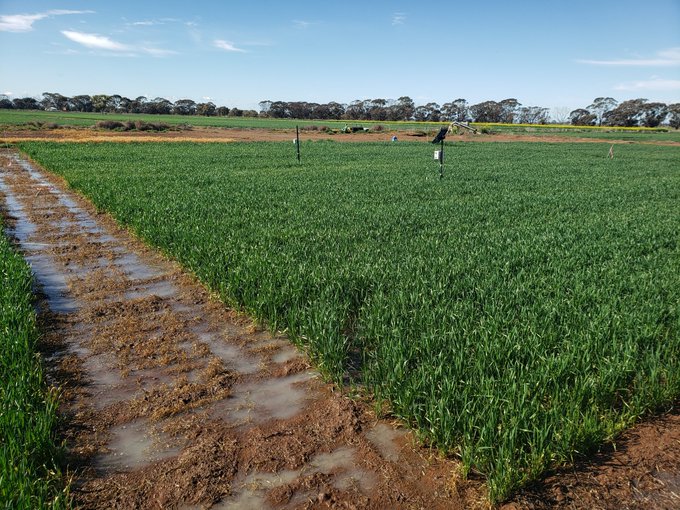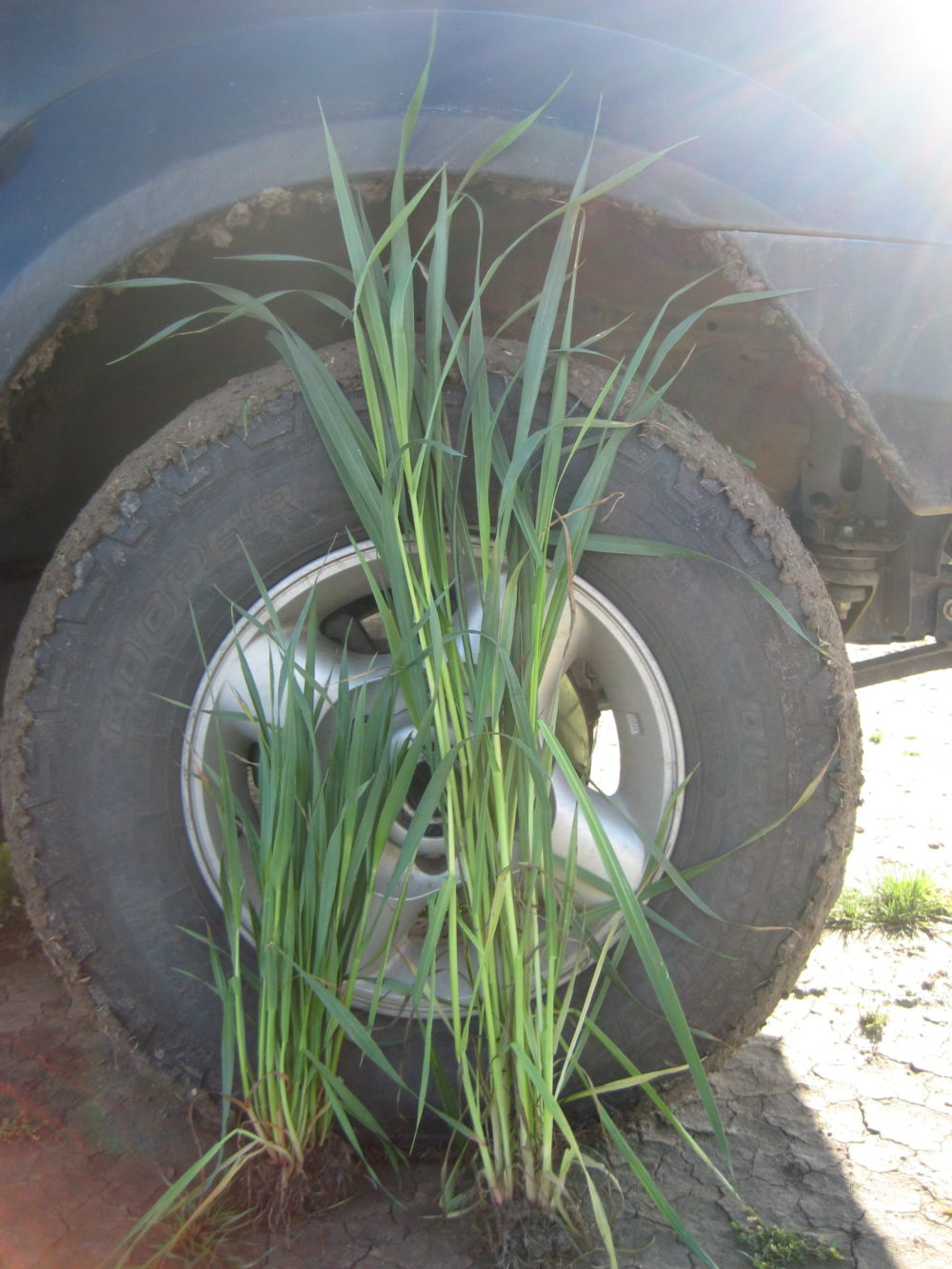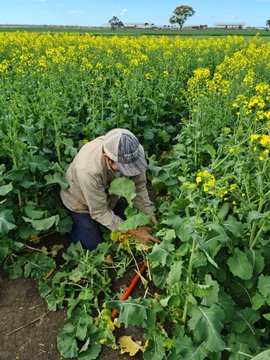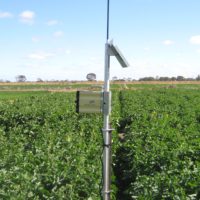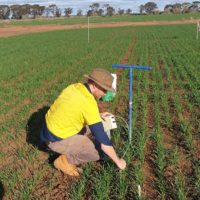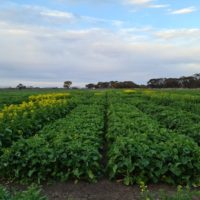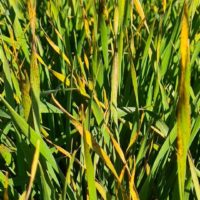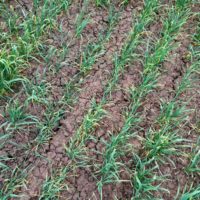Trial Block Update
April 2023
An update on the benefits of waiting to do Deep N soil tests in winter.
After the January/February 2011 floods, we sampled in April prior to pre-irrigation and the results that were no different to the usual – soil N was around the 70 – 80 kg N/ha. Did the usual N budget taking in to consideration the soil N we had, the starter fertiliser and the expected mineralisation during the season to calculate the required topdressing rates. At harvest, our wheat protein was around 9%. Doing a bit of a math, we were about 80 kg N/ha short – the amount of N we usually expect from mineralisation. So what I think occurred is that the flood in late summer resulted in the mineralisation that generally happens post pre-irrigation, happened beforehand and so we ended up being short. An in-crop test would have alerted us to the lack of in-crop mineralisation.
Now the 2022 flood happened in November rather than February, and the crop residues that mineralised in 2011 were still crop in 2022, so there are some differences.
We are about to commence a new GRDC project, the National Risk Management Initiative, that will let us study the ‘life’ of N fixed by faba beans and then when and how much is released over subsequent seasons. The ‘when’ will be assessed by a series of soil tests during the season and beyond, and the ‘how much’ via crop measurement and soil testing. We will follow two irrigated faba bean crops – one under overhead and the other surface irrigated. Southern Growers at Finley and IREC will be irrigation partners in this project.
With some 0-60cm soil sampling started, it was good to see some decent soil moisture below 30cm. Obvious to those already or finished pre-irrigating, this has resulted in saving a bit of water – looks like we are using about 0.7 Ml/ha in the first couple of bays.
The other task our team is starting is the seed preparation for sowing. Each plot needs its own little bag of seed and we adjust the amount of seed sown to reflect the seed weight (g/1000 seeds), target population and expected establishment. Looking at the 2022 wheat trial, the differences in seed weight meant we had sowing rates that ranged between 79 and 123 kg/ha, assuming a high germination and 70% establishment rate (ie of every 100 seeds sown, 70 will form plants). Given the difficult end to last season, have you checked your germination and seed weights?
The take home messages are:
Deep N soil testing in-crop can give a more accurate N picture.
How good is your seed for 2023? Don’t wait until after sowing to discover your seed is shit.
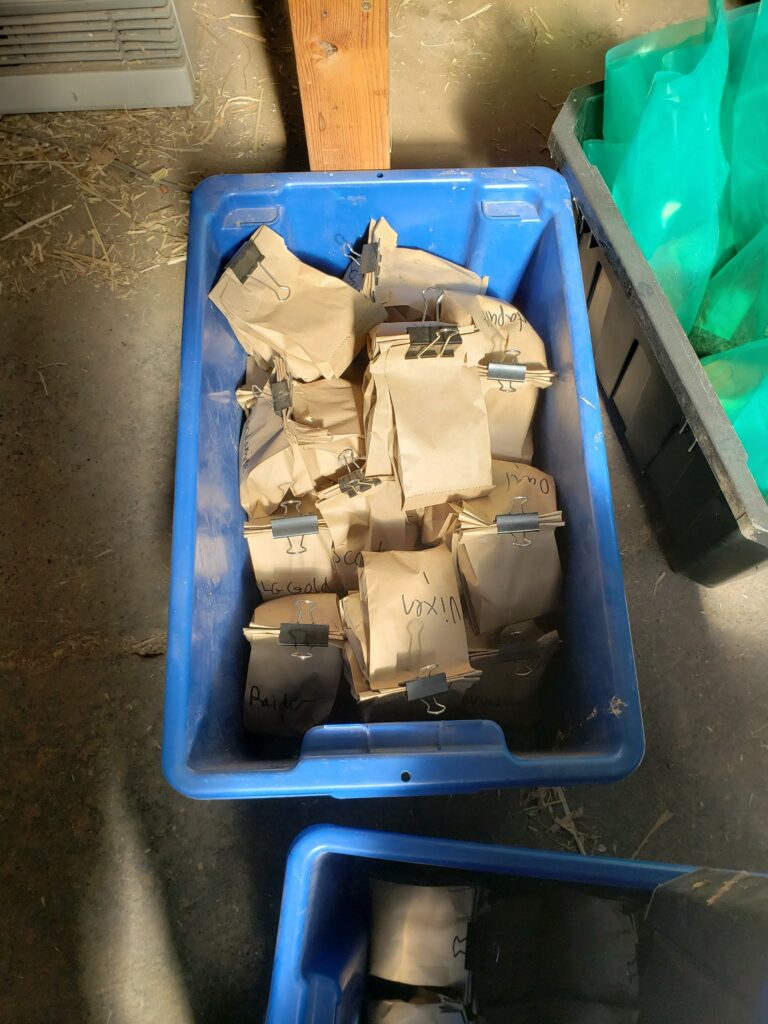
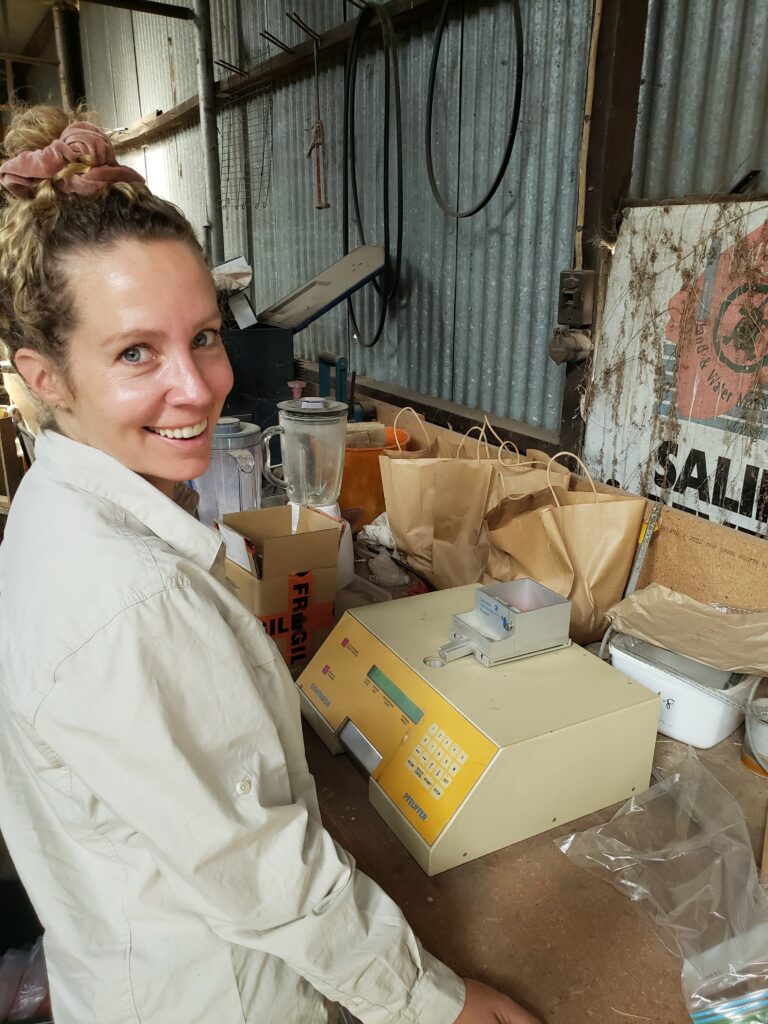
March 2023
Post Flood Results at the Trial Block
Site preparation has continued through February in anticipation of pre-irrigation in early April. Legume stubbles have been muti-disced in (where possible as chickpeas are like hard sticks at the moment) and some minor levelling has taken place. Generally, the soil has come up well – not too cloddy and not too fine. Soil samples (0-10cm) were taken and analysed to determine what are nutrient status is and then allow us to plan for winter 2023.
Looking at the results of the soil test, nothing seems that out of the ordinary.
Phosphorus levels are fine (greater than 60ppm Colwell), so P rates will simply be replacement ie 8 t/ha wheat crop will remove about 24 kg P/ha or 125 kg DAP/ha.
Sulphur is fine, thanks to a gypsum history. pH is neutral, so no need for lime. Potassium greater than 400ppm so no action required.
N is relatively high at around 50 kg N/ha in the top 10cm, but more about that later.
Two areas that need attention are zinc levels and our declining organic carbon.
Zinc can be remedied with treated starter fertilizer but OC will take a bit more work. Discing in stubbles will help, especially legume stubbles. Cereal stubbles will need to be broken down rapidly in an attempt to turn them into soil OC rather than just simply left to slowly rot away – just like a very slow burn. With good fertility, pre-irrigation and warm autumn temperatures, we should be able to provide the best conditions for rapid breakdown.
Breakdown of plant residues releases the nutrients they contain. Depending on the residue, it might be significant eg nitrogen from legume stubbles or not much from weathered cereal straw. As mentioned above, the plant residues need to be broken down, or mineralized, for these nutrients to be released. Only then do they become available for plants to take up. Of particular interest is nitrogen. The legume or pulse residues from last season start to mineralize once moisture is available for the microbes to do their work. Pulse stubbles can have a considerable amount of N in them, eg we have seen N levels of approximately 200 kg N/ha after a failed faba crop. This mineralized N is an important part of the N budget for the crop we are about to sow and we should be measuring it so as we can ensure we provide enough N to meet targeted yield and avoid excess.
Soil testing to 60cm is a good start to work out what N is available. It is easy to do prior to sowing but it may underestimate the N that will be available to the crop, especially if it has been a dry summer and autumn. As mentioned above, we need the microbes to mineralize the plant residues and this will not happen when it is dry. There may be a lot of N after a pulse but not until it is ‘released’ by the microbes. By pre-irrigating, or good autumn rains, we provide moisture and the autumn provides the warmth for the microbes to flourish and rapidly mineralize the stubbles (and if the microbes have enough nutrients themselves). We get a burst of N (and other nutrients such as P released) in the autumn. The strategy at the Trial Block is to do our N testing in late June – the autumn flush will be over as the soil is now cool, and we have time to get the test results back and plan our topdressing rates to meet the crop’s requirement. Yes, it is more difficult to take soil samples in-crop and access may be an issue, but I think we get a far more accurate result on what is actually happening in the paddock than an earlier test when it has been dry in the autumn.
The take home messages are:
Soil test. Most nutrients levels move slowly so once in 4 or 5 years lets you know what is happening, particularly if you have been replacing P (amount out = amount in) each year.
N is a different story and will differ from year to year depending on rotation and rainfall.
You need a deep N test to know what your soil N levels are. This is essential knowledge when deciding on topdressing rates.
My preference is to test for N in early winter but autumn will do (just not as accurate).
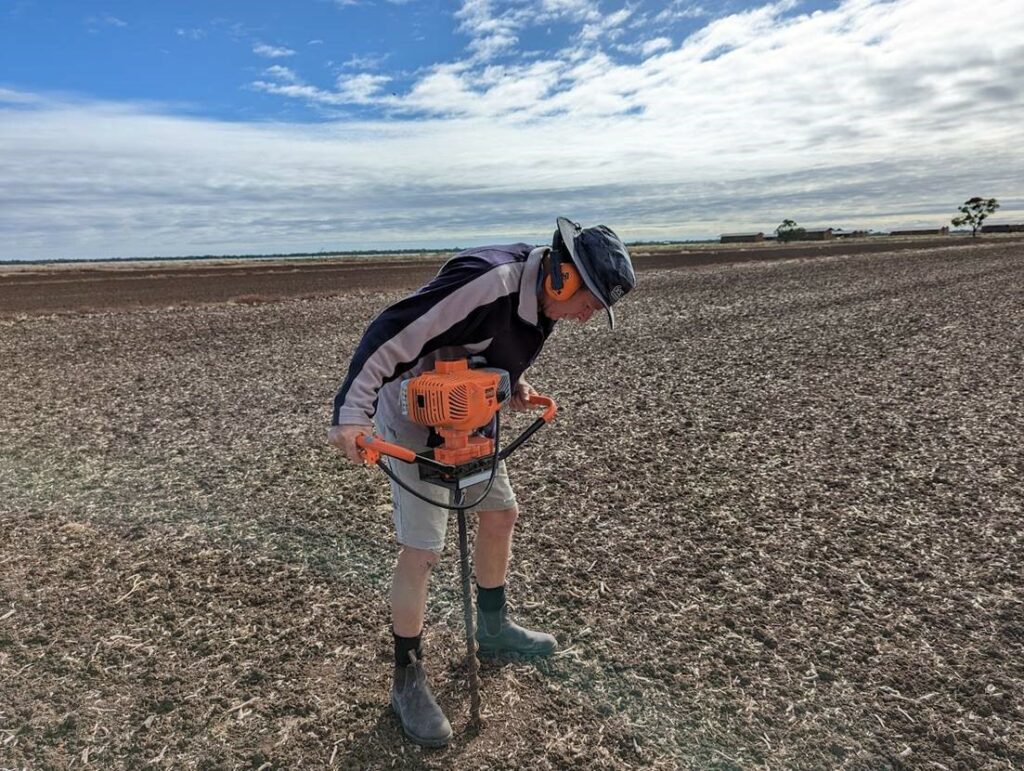
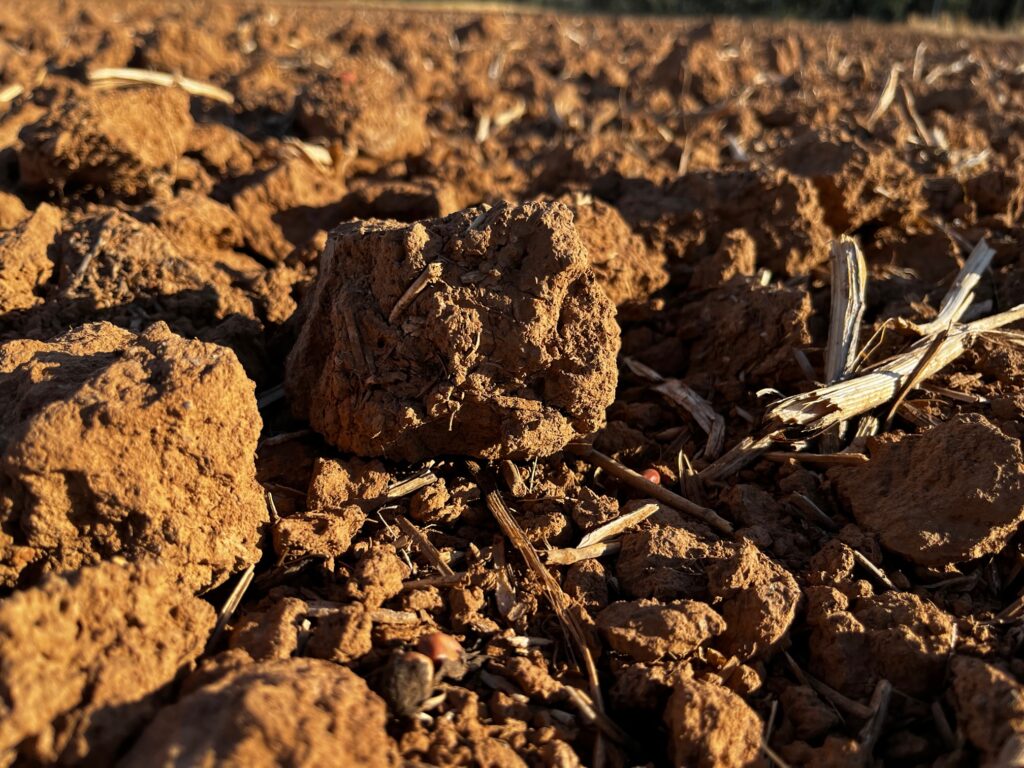
February 2023
Post Flood Observations at the Trial Block
As the floodwaters receded in late November, the soil remained quite wet for an extended time. Definitely unlike irrigation where the soil (and particularly the soil surface) dries reasonably quickly and a small number of ‘puddles’ remain after a few hours. As the crops matured and began to lodge/collapse, the soil dried even more slowly.
At harvest, the soil resembled a cobblestone road – the surface had begun to crack into hard blocks that ‘floated’ on top of the still quite wet subsoil. Prolonged driving over the same piece of soil saw ruts begin to form as the subsoil was compacted/squeezed sideways. This did not fill me with much joy as we began to plan for 2023 and what we would have to do to get the soil into some sort of shape for sowing.
I do not want to cultivate unless absolutely necessary because of the nature of our soil at the Trial Block. Twenty years ago we followed the standard practice for transforming a pasture paddock ready for cropping by discing, then disc again, then smudge twice. This resulted in destroying any soil structure, and following pre-irrigation, the soil became a slimey mess where sowing tynes simply opened up slots in the soil. ‘You should have put on some gypsum’ is the usual response, but our surface soil is slaking, not dispersing and so gypsum will have little benefit. Not cultivating and improving our soil organic matter will!
So, as we come in to February, the soils are beginning to repair themselves. By drying and cracking, the compaction from inundation is relieved and the ‘self-mulching’ characteristic of our soil is returning. Taking the 0-10cm samples for nutrient testing was easy on the red dirt and where we had crop in on the grey dirt. Where there was fallow or heavy stubble cover, the soil is not drying as quickly and this process is not as advanced.
We will do some light and shallow cultivation to help manage our crop residues, but we will keep it shallow and to a minimum
Take home messages are:
Don’t cultivate for cultivation’s sake.
Have a look and see what is happening to your soil
Know what is driving your soil issues; slaking or dispersion can be tested by a simple test as only dispersion is fixed by adding gypsum
Soil test now so you know where your nutrients such as phosphorus, sulfur and sodium levels are. Nitrogen is a different story. Testing now is easier but a more complete picture might be best determined by a 60cm test in winter. I will explain more in the next newsletter.

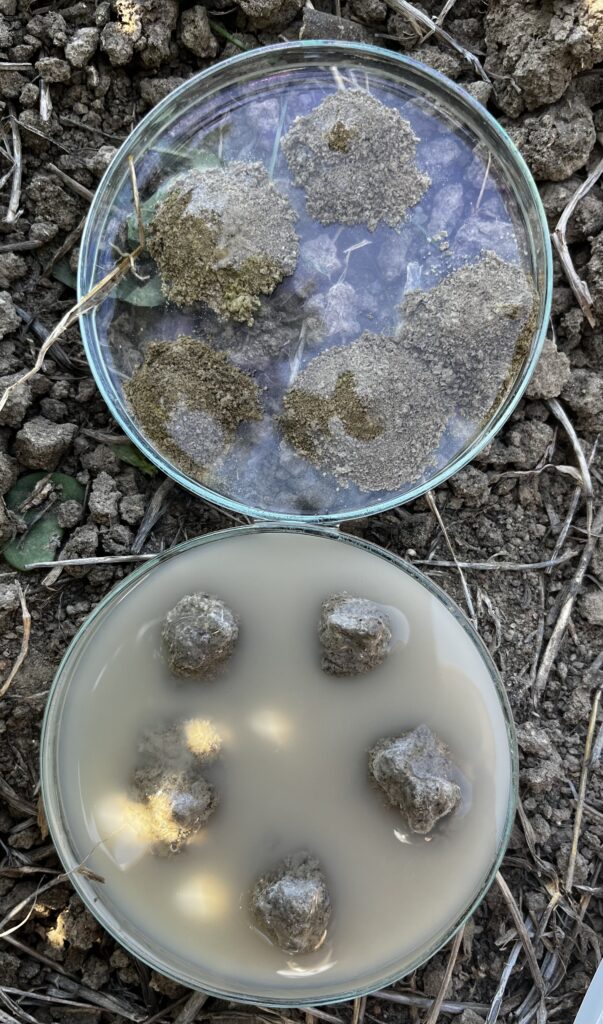
December 2022
Due to the flood and subsequent inundation and waterlogging for close to a month, harvest has been a bit hit and miss, with a lot of misses. If I take a world cup view – Floods 1 Results Nil (well almost depending on the crop)
As the floodwater receded, the various crops ‘collapsed’ and the lodging was worse the longer the plots were in the water. From a research perspective there was no way to accurately split the plots back out so we could attribute yield to treatment. As a result, no canola trials were harvested as we saw both lodging and shattering. The stems seemed to be weakened at the point where the water got to and so many stems simply split open. Barley was similar and any harvest results would have been compromised by the number of heads left on the ground and moisture damage. Chickpeas didn’t have any pods on them prior to the flood despite the best vegetative crop we have grown (and where we kept disease at bay). Fabas collapsed and died when the water hit and so we were left with a tangled mess and half filled beans.
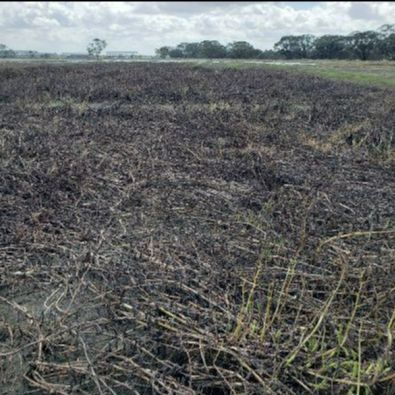
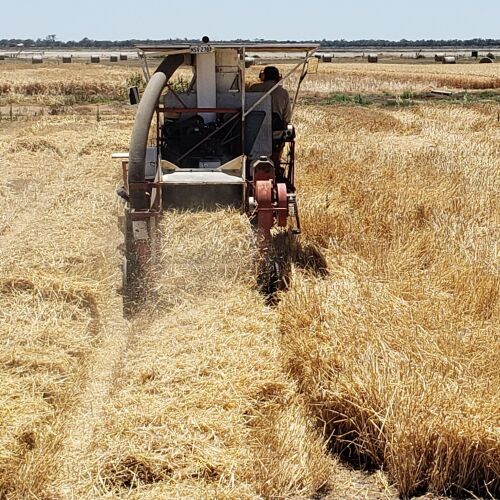
Wheat has come out as the most resilient. The main season trial averaged 6.9 t/ha, with Zanzibar topping the yields at 8.8 t/ha. Stripe rust control was critical with the average loss of the unsprayed plots being 56%, ranging from 3% to 93% loss. Short season trial average was 4.9 t/ha and the long season variety trial averaged 6.2 t/ha, with stripe rust playing a part in yield reduction. The longer season red wheats, with their better rust resistance, yielded well, with Anapurna averaging 8.5 t/ha. Durums are a mixed bag. Overall yields are down on expectations and grain quality varies from OK to very poor, with anything that has lodged yielding very poorly.
Late November 2022
The Irrigated Cropping Council research site on the outskirts of Kerang went under floodwaters on the 30th October. The waters have finally receded leaving a very wet research site, Damian and the team where able to walk into the site to assess damage as best they could on the 21st November. Although there are still some unknowns the ICC has made the below decisions:
To write off the canola trials. These have lodged and it is shattering despite us being an estimated 3 weeks out from harvest. Flooding occurred prior to the trials reaching suitable maturity for windrowing; with the now tangled and lodged state of the plots we would be unable to manually separate them without causing even more shattering.
To write off the Chickpeas. These are now defoliated and have set very few pods.
To write off the faba beans. These have lodged and tangled to the point they will be impossible to split to get the header through as when you try and lift them plants just snap off at ground level. We have noticed a large amount of variation in pod fill across the trials with some being only skins and some filling nicely.
The Barley has lodged and as harvesting these will be incredibly challenging, we have written off the variety trial and PGR work
The Optimising Irrigated Grains durum’s on the sprinkler bay are haying off without filling. As the bay is standing, we will run the header through it to minimise the amount of cleanup but we are not expecting to get a yield result that will be usable.
The unknowns:
Currently the Optimising Irrigated Grains durums on the flood bay are looking ok, there is still some green plants and so far, they look to be filling grain normally.
The Optimising Irrigated Grains barley nitrogen trial is severely lodged but we can visually see differences that should translate into yield differences. As it stands currently it will be a challenging harvest where we will need to manually split and feed plots into the header. As such we will keep an eye on it, heads are very wet under the lodged canopy. If we believe that we will be able to harvest without creating too much variability then we will go ahead and do it. If not, a hand harvest solution could also be an option.
The wheat variety trial is mostly standing and looks like it will harvest at this time. We will assess the data as it comes in to make sure that harvest variability due to the impacts of water are not too high.
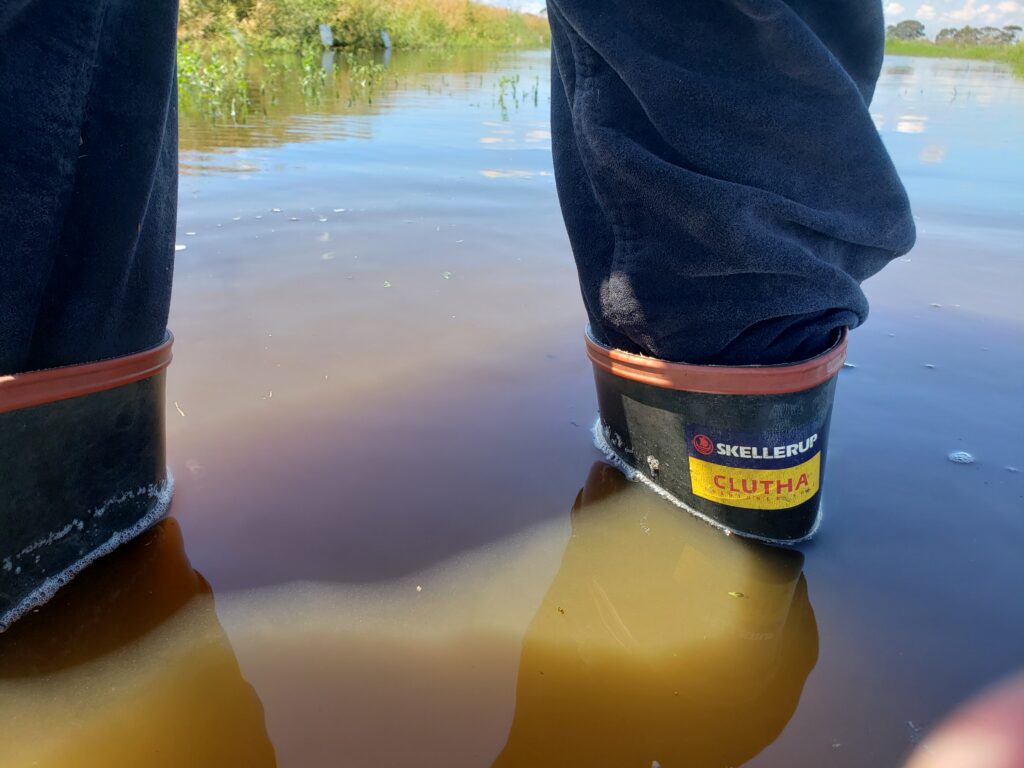
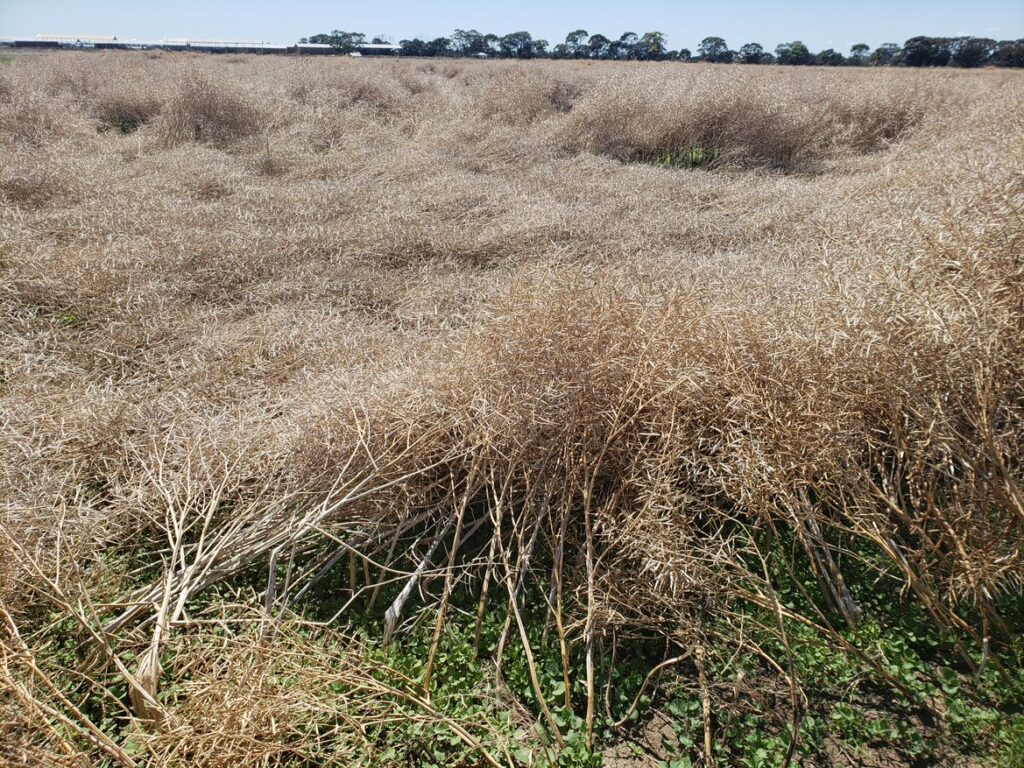
November 2022
You may be aware that Kerang was in the news with regard to the threat of flooding from the Loddon River. Fortunately we are on the other side of town and the threat from the Loddon passed without incident.
Unfortunately we are subject to the whims of a swollen Pyramid Creek that decided to make sure we are an ‘irrigated’ trial block. On Monday 31 October, flood waters started to creep up the bays and by Wednesday morning, all of the trial block was inundated. As of 11 November, water levels range from about 150mm to 350mm deep across the various trials and falling very slowly.
So what does that mean for the trials? I’m not sure at this stage, as most trials still have the grain portion out of the water. So we hope any forecast rain does not create any more lodging and the Pyramid Creek starts to fall quickly.
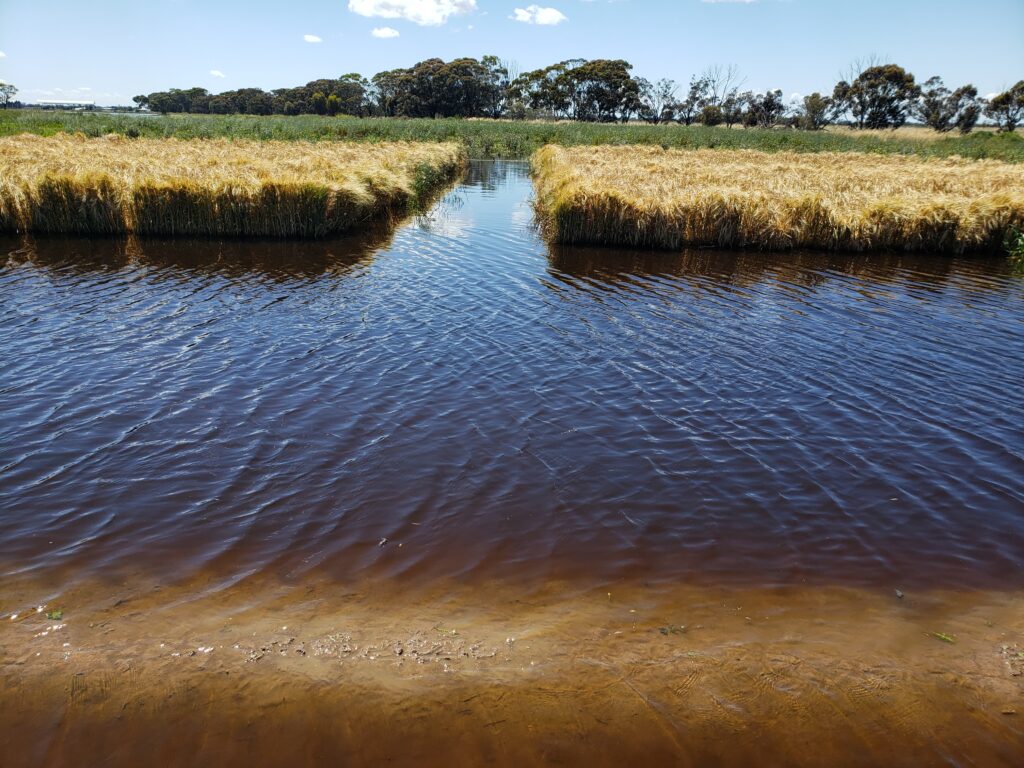
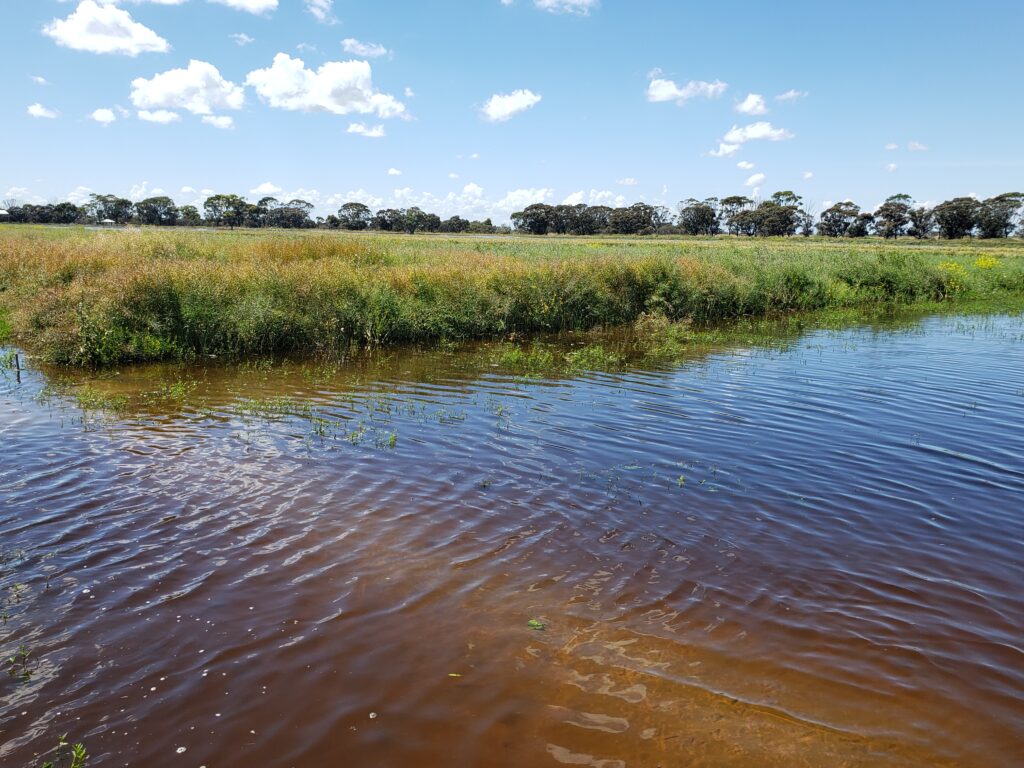
Despite what has happened in the past month, we have observed a few interesting pieces of agronomic information. Chickpeas do not like cool humid conditions and Ascochyta has wiped out unprotected plots. Even plots that received chlorothalonil treatments have suffered substantial defoliation. Yet to be confirmed, but despite growing the biggest crop biomass to date, podding in the chickpeas has been extremely poor and I suspect that this is due to the near constant full soil profile through September and October. The small variety trial we have sown did also demonstrate that all ‘MS to ascochyta’ ratings may not be equal.
Our fodder trials have almost got through before inundation, with the peas, balansa clover and fabas all exceeding 10 t/ha. Quality may not be the best as the stems of the peas and balansa reached up to 180cm long and rainfall had seen the lower canopy reduced to brown slime.
The rain in October resulted in most of our faba bean trials lodging, as well as higher than normal level of disease in the canopy. A new breeders line from the University of Adelaide did remain standing despite everything else collapsing, so it will be interesting to see if the yields stack up as well (flood response dependent of course). Chocolate spot was being held at bay by our fungicide program but had hit the untreated plots quite hard at the time of immersion, with the older variety Fiesta suffering more than the newer release PBA Amberley.
October 2022
Soil N
Soil cores to 60cm were taken in late June to assess soil N, allowing us to see what was present in the soil so we can calculate the N budget to reflect the target yields. Soil Ns were reasonably high, ranging from 90 to 140 kg N/ha. Topdressing rates were then calculated accordingly assuming 4 t/ha for canola and 8 t/ha for the cereals. The canola variety trial received 145 kg N/ha (about 300 kg of urea) and the wheat trials received 180 kg N/ha (or about 390 kg urea). The Durums with their higher N requirement in trying to achieve 13% protein needed 275 kg N/ha (or close to 600 kg urea).
Irrigation
Irrigation has only happened on the canola in Bay 8 and across the sprinkler trials in Bay 9
Irrigated Variety Trials
Barley
Barley Variety trial – Black, Commander and Latrobe have lodged. Others have minor areas lodging.
Relatively disease free following a fungicide application at GS31/32.
Barley PGR – finished flowering. All treatments have been completed. At this stage the treatments that have suppressed crop height are grazing and the late application of either moddus or ethrel. Some lodging is starting to occur in the control.
Barley NUE GS69 cuts have been completed. Some lodging is starting to occur in the higher rate treatments but not consistently.
Canola
Canola Variety Trials – most finished flowering 20/9 and almost all by 25/9. Flowering period average is 47 days, about 5 days longer than average. Doesn’t seem as tall but inter-rows have already closed up.
Canola NUE Rates and Timing – Could pick the ‘0’ treatments at mid-bolting. Biomass is a little down on 2020 and about the same as 2021 as assessed at the early flowering cut, at around 6 t/ha for the treatments that have sufficient population and N applied. This is a little below the nominal target of 7 t/ha but this is a target suggested for high yielding dryland crops and we seem to be able to grow more biomass during the flowering period. As a rough summary, we have plateaued biomass at 80 kg N/ha, irrespective of timing and at a seeding rate of 60 seeds/m2 or about 40 plants/m2.
We are also seeing similar biomass from the TTs vs RR and we are seeing similar biomass in both the flood and overhead irrigated trials.
Durums
Some stripe rust is evident in the disease management trials, with Vittaroi more susceptible than Aurora. The plots that received a fungicide at GS31 were still clean at GS39, when the next round of treatments was applied.
Fabas
Little disease is present in all trials.
Biomass is similar at early flowering in both the flood and overhead trials, with a trend to higher biomass with increasing seeding rate.
Wheat
Stripe rust was noted in early August in the main season trial, but not the long season trial. The main season trial was sprayed in response, but 1 rep was not sprayed. Both trials were sprayed again at approximately full flag emergence, and by this time the long season trial was showing stripe rust symptoms in 3 varieties, whereas the 3 sprayed reps of the main season trial were clean.
Heat Stress Trial
The Heat Stress trial has 3 time of sowing – 15/5, 26/6 and 2/8. The second sowing resulted in patchy emergence thanks to minimal in in July. The open pollinated trial lines definitely have less vigour/resilience as the buffers are quite good but we have about 12 plots out of the 96 that have less than one plant/m2. We will be able to get sufficient data from the rest of the plots.
September 2022
Site Overview
Preparation for the 2022 winter trials started in March with judicious stubble burning and multidiscing of brown manured wheat residues.
Pre-irrigation began on April 6th for the majority of the trials. Canola trials were not pre-irrigated as we water up post sowing. Unexpected rainfall on April 18th kept the pre-irrigated bays too wet for sowing, and so the long season wheat and Murray Dairy Fodder for the Future trials were delayed. Sowing began on April 26th with the canola, cereal fodder and long season wheat trials.
With April receiving 75mm of rain, on top of 40mm in March and more rain forecast, it was decided to not water up the canola trials. This did raise the prospect of a winter drought if we did not get adequate winter rainfall before the opening of the irrigation season in mid-August, but the risk of waterlogging the trial by watering up and follow-up rain was too great.
May rainfall was average (35mm), but sowing of some trials were delayed, e.g., the main wheat variety trial and the chickpea time of sowing trial. The Fodder for the Future legumes trial was sown on May 6th, followed by the wheat, barley, faba beans and a majority of the chickpea trials on May 10th and 11th.
The durum wheat trials were sown on May 23rd (on time) and sowing of the short season wheat trials was on June 14th (a little later than planned but delayed by the site being too wet).
Rain in late June enabled the first topdressings of the canola nitrogen use efficiency trials and the cereals for fodder trial.
Topdressing continued in July, but with limited opportunities as only 11.8mm was received for the month. Some events were less than forecast and barely enough to dissolve the urea.
Rainfall in early August saw a flurry of N topdressings. Overall, most trials were topdressed on time and no nitrogen deficiencies were noted thanks to most trials having in excess of 100 kg N/ha present in the soil at sowing. However, there was evidence of N deficiency in the delayed N treatments in the canola N timing trial where the first topdressing was applied at the green bud stage.
August also delivered on the wet winter promised, with 48mm for the month. August also saw the arrival of stripe rust in the wheat trials (noted on August 10th) and Ascochyta in the chickpeas (noted on August 5th).
The canola trials had begun to show signs of wilting on the windy and sunny days in late July. Monitoring of the soil moisture showed adequate moisture in the top 150mm but drier conditions at depth. Irrigation was planned for August 15th, but delayed with each rainfall event. The first spring irrigation of the canola trials occurred on September 2nd, keeping in mind that these trials were not irrigated in the autumn.
June 2021
Site Overview
2020 Summer Trials
- Maize harvest is complete, thanks to the assistance of Pioneer. We saw the same trends in the nitrogen response trials as last year, there was no yield response for rates above 240 kg N/ha and it didn’t matter when you put the N on, as long as you applied a majority of the N by 8 leaf stage there was no yield penalty or gain.
- Forage sorghum yields exceeded 17 t/ha spread over 3 to 5 cuts depending on type.
- The Dairy Australia summer fodder trial looked at different forages (grain sorghum, sweet sorghum and maize) and irrigation strategies with some interesting results. The highest forage production was maize, both in total biomass and per megalitre, although moisture stress did reduce production it was not as much as we expected. We are still waiting on feed quality results.
2021 Winter Trials
- Sowing started in mid March with a winter canola demonstration for Pacseeds and finished with the Optimising Irrigated Grains project durum trials on May 24th.
- There is a broad range of trials sown this season – forage production, variety evaluation, nitrogen management, sowing rate and timing, disease management and a research project looking at the effect of heat on canola pod set and grain fill.
- Most trials were pre-irrigated but the dry April and May saw some trials almost being sown dry and needing the showers to achieve germination.
- A couple of pests have been noted this autumn. Volunteer cereals scattered across the Trial Block have been infested with Russian Wheat Aphid and rabbits have been looking for something green to eat.
December 2020
Site Overview
December was wetter than average, with 47.4mm (decile 9) for the month, mainly due to a 35mm event mid -December 16th. December temperatures were slightly lower than average for both minimum and maximum temperatures.
This brings the annual rainfall to 424.6mm (decile 7) and a growing season of 251.9mm (decile6). It wasn’t a consistent year, with the first 4 months rainfall being well above average, and a dry to very dry May, June, July and September.
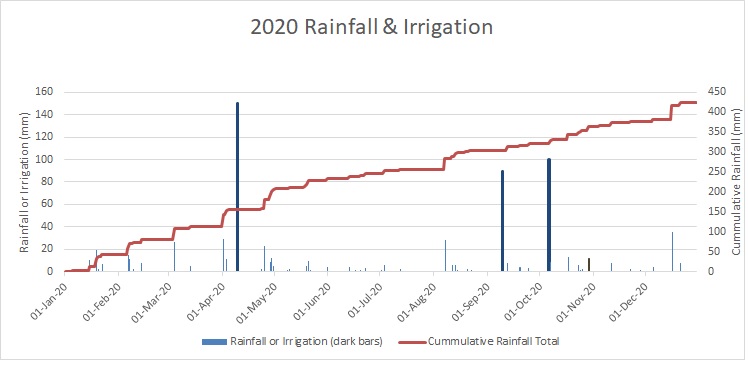
Another weather factor at play is the amount of solar radiation. Research has established a link in wheat between the temperature and amount of solar radiation in the 30 days prior to flowering. 2020 had lower radiation for August, September and October than average. So what does this mean? For 2020, it meant that potential yield was going to be lower than average and for the bigger picture, it explains why we will not achieve the record yields in our districts that other areas like New Zealand and Tasmania, despite the best agronomy and irrigation management. For more information of the effect of solar radiation has on yield, see Sam North’s ‘Soils under an irrigated environment’ ICF0008 Final Technical Report summary where he discusses the yield ceiling due to our environment and how achieving 10 t/ha wheat crops every year is unrealistic.
The wheat and faba bean variety trials were harvested in December.
The faba bean trial averaged 5.7 t/ha, with PBA Marne and PBA Bendoc the best performing varieties. Top yielder was a line AF14092 at 6.3 t/ha. We also sowed a ‘late’ trial of Samira, Amberley and Bendoc in late May that had a slightly higher average yield, with a smaller biomass and less lodging.
The quick maturing wheat variety trial, sown May 29th, averaged 7.6 t/ha, with Vixen, Devil and Razor CL yielding in excess of 8 t/ha. Mace and Emu Rock were affected by stripe rust. This trial was sown amongst the durum trials where most trials averaged 9 t/ha. So if quality isn’t a consideration, then consider the durum wheats as a high yielding option for late sowing.
The main season wheat variety trial averaged 8 t/ha, with RGT Zanzibar (a red wheat) the highest yielding variety at 10.3 t/ha. There were several varieties yielding in excess of 9 t/ha including Rockstar, DS Pascal, Cobra, Sherriff CL and Beckom.
The longer season wheat variety trial, sown on April 17th, averaged 7.9 t/ha, with Anapurna (a red wheat) topping the yields at 10 t/ha. Rockstar and Coota yielded just over 9 t/ha.
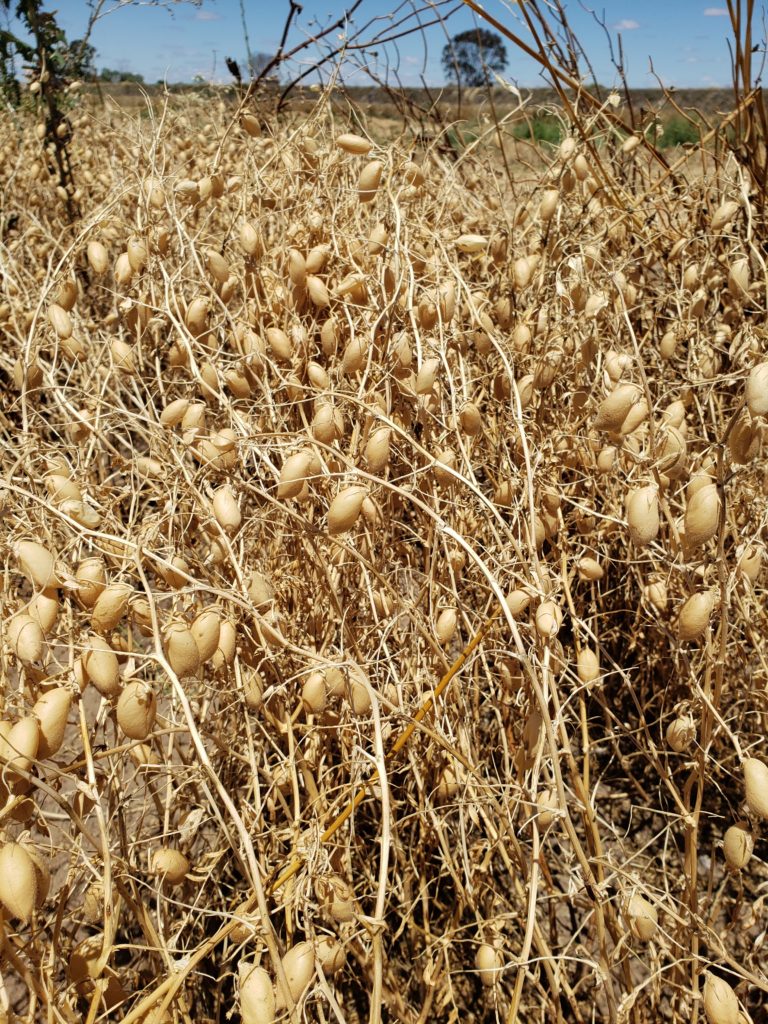
Barley: RGT Planet was the highest yielding variety at just under 8 t/ha, in a trial that averaged 6.5 t/ha.
The later maturing Cassiopee barley sown early did not convert high biomass to higher yields thanks to lodging and brackling. Highest yield was achieved by applying 120 kg N/ha, and yield declined with higher rates. Sowing rates targeting 100 plants/m2 (77 kg/ha) yielded just as well as higher rates.
The canola trials demonstrated the adage ‘bigger is not necessarily better’. Our ‘sprinkler’ and ‘flood’ trials had an average biomass on 14 t/ha and 16.7 t/ha respectively, but grain yields were almost exactly the same at 3.89 and 3.88 t/ha. Similarly, the variety trial was taller and more tangled than usual but didn’t quite reach our best ever yields.
Flood irrigation enabled the trials to avoid moisture stress and to flourish over winter, while the sprinkler irrigated trials did suffer from moisture stress in August before the opening of the irrigation season. Canola was able to respond when water became available, but durums and fabas failed to respond in a similar fashion and yields were reduced.
Given the site had a starting N level of around 200 kg N/ha, it wasn’t surprising that canola yield did not increase where applied N exceeded 80 kg N/ha in one trial and around 160 kg N/ha in the other. One difference was the later N application timings resulted in higher grain yield.
PGRs in fabas failed to achieve any meaningful reduction in lodging. High (32 plants/m2) plant populations did result in greater lodging well before harvest.
The pulse disease trials did not demonstrate any yield benefit from the various fungicide strategies. The up side to dry weather and few local crops.
Similarly in the durum wheat fungicide trials, the various fungicides and seed dressings were effective in preventing stripe rust infection, but yield was not affected in the ‘no fungicide’ treatments. The untreated plots did become infected, but timing is everything. When the flag leaf emerged, the environmental conditions did not favour further infection and the flag remained relatively unaffected while there was a loss of nearly 50% of the lower canopy green leaf area. In the other wheat trials were infection occurred on the flag, yield appeared to be reduced.
Take note of the plant habit when selecting chickpeas for irrigation. The older Genesis 090 is a more upright plant and had better yields and harvestability compared with the newer Monarch that tended to be a more sprawling plant. 30 plants/m2 also seems to be an adequate chickpea population for irrigation.
Full results and discussion will be available in March 2021
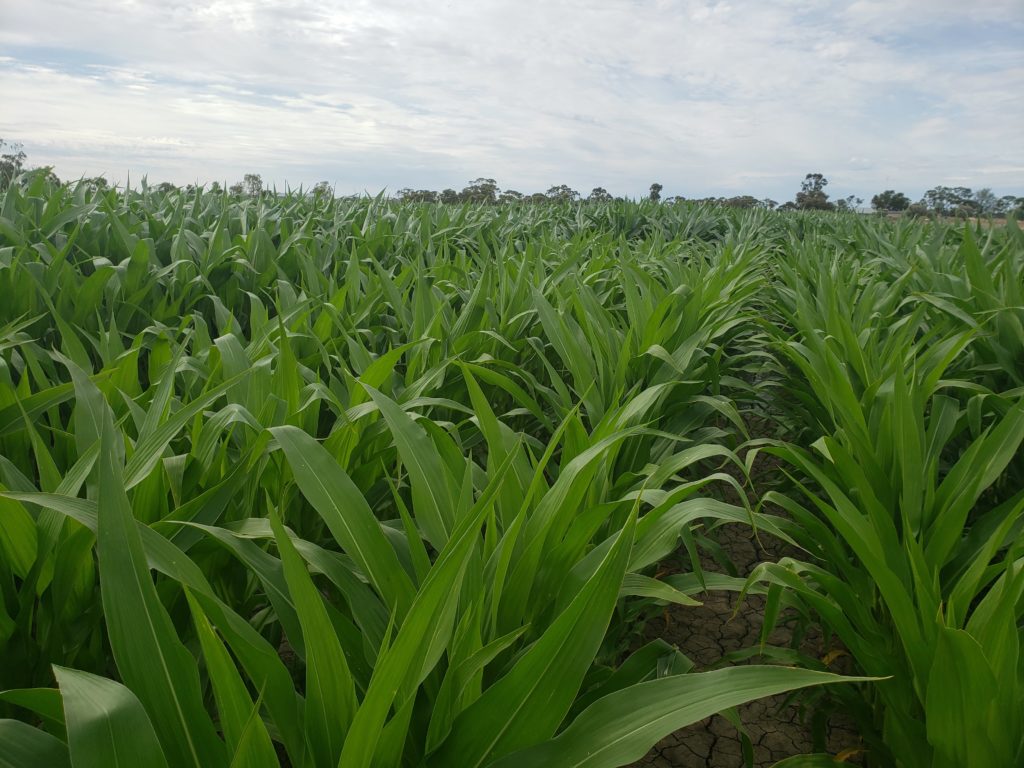
The GRDC Irrigated Grains project is looking at Maize agronomy with a particular focus on nutrition. We are continuing the Nitrogen trials which gave us a great base to work from with the development of nitrogen response curves for the site. This year following feedback at last year’s summer field day we have included a trial taking a closer look at using leaf testing to make in-season decisions on maize nutrition.
Other trials include:
- Nitrogen rates
- Nitrogen timing and products (ie entec urea upfront)
- Row spacing (20 and 30 inch) x Population (89k and 110k) x N rates (300 and 450 kg N/ha)
- Fungicides
- Leaf tissue testing, monitoring and response
You can check out the interim results from the GRDC maize trials at https://irrigationfn.com.au/resources/maize/
Save the date for our summer field day for this site – Thursday 28th January from 9-11am
We continue to host the Pioneer Strike Trials at the site and are working with additional partners to include summer forage research on the site. A Murray Dairy funded trial is investigating the impact different irrigation strategies on forage maize and sorghum and Pacific Seeds have a forage variety trial at the site.
Next Month
- Summer weed control.
- Selling hay – any interest for wheaten hay rolls?
- Maintenance of the summer cropping program.
November 2020
Site Overview
October was slightly wetter than average with 44.4mm (decile 7) for the month. The weather seemed to lock into a weekly cycle of low pressure systems delivering 12mm and cool temperatures.
The second spring irrigation did occur for all trials in October, most trials have received 2 spring irrigations, or approximately 2 Ml/ha and 3.5 Ml/ha for the season. The cereals, fabas and canola on the grey soils were irrigated on October 7th, and those on the red soil on October 14th. Except for the later sown durums, these will be the last irrigations.
Variety Trials
The canola trials were very close to being at the stage to windrow at the end of the month, but many plots are particularly large this year and the windrower may have issues with allowing the crop through underneath. So a decision will be made on whether we actually direct harvest this season after a few trial runs.
The wet and windy weather exacerbated the lodging in the variety trials. On irrigation, we quite often see very different responses in varieties from dryland. That is to be expected when a particular variety is targeted to a low rainfall zone and then is then planted on irrigation and pushed well beyond its intended limit
There are many factors that result in lodging, and many are not the fault of the variety. As part of the “Optimising Irrigated Grains” project Cassiopee, a long season barley, has been treated with differential rates of Nitrogen. Observations of lodging indicate that plots that have received nitrogen in excess of plant requirements is resulting in increase lodging. We saw a similar effect in the 2007 barley germplasm evaluation where rates above requirement resulted in high levels of lodging and a yield of 4.5t/ha in comparison to lower levels of lodging and a yield of 7t/ha where inputs matched plant need.
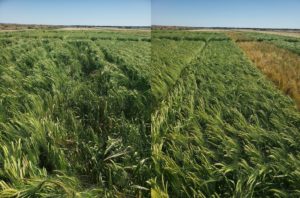
Optimising Irrigated Grains long season barley trial: Cassiopee – 320 kg N/ha (LHS) and 120 kg N/ha (RHS). RGT Planet is the more mature variety on the right of the photo and has not lodged.
This season has tested many varieties, we’ve seen a new strain of stripe rust, lodging and maturity differences meaning varied responses to late season rains. There has been a huge amount of discussion on social media about the merits and failures of various varieties, while we’ve all been following with interest, we encourage you to consult comparative information which has been generated over multiple years, such as NVT, the crop sowing guide and the ICC variety results when making your variety selection. Ensure your membership is up to date to receive the yield results from the variety trials at harvest.
“Optimising Irrigated Grains”
Many of the trials are looking at nitrogen use efficiency in long season barley, canola and durum wheat. This includes rates as well as timing based on crop development. All treatments have been completed and the next phase of dry matter cuts will start in November just prior to harvest.
The yield results from the ‘sprinkler versus flood’ trials of canola, fabas and durum wheat will be interesting to see. At the moment, flood irrigation, and its ability to provide soil moisture over winter until the irrigation season begins, has seen higher biomass produced so far. It is very apparent in the fabas where the flood irrigation trials are now lodging and over 120cm high while the sprinkler trials are approximately 70cm high but well podded.
Smarter Irrigation for Profit 2
The 2020 SIP2 trial is looking at the effect of irrigation timing and volume on wheat yield. The demonstration is a combination of treatments using either plant growth stage or soil moisture to schedule irrigation. The ‘at flowering’ irrigation treatments were applied in early October, again successfully via the Netafim dripper tape that mimics flood irrigation.
October 2020
As I write up the September summary, it is very tempting to pile on the BoM and their promises of a wetter season. At Kerang, it has been only fulfilled in April and August with September dropping the ball with a decile 2, 16.6mm.
The ‘red dirt’ trials were irrigated in August, including those that were pre-irrigated. Despite how odd it felt to wear gumboots to walk in and change the bays over we made the decision to irrigate based on the soil moisture data from the probes installed in the Smarter Irrigation for Profit 2 block. These showed that despite the above average rainfall in August it was failing to wet the profile to 30cm. These trials received their second spring irrigation starting on September 15th.
The ‘grey dirt’ trial received their first spring irrigation on September 8th. Thanks to Rubicon, we have two soil moisture sensors installed comparing areas that have been pre-irrigated on a flood system with not pre-irrigated on a sprinkler system. We are still fine tuning our irrigation trigger points, but the probes were suggesting we were getting close to the refill point on this date and irrigating at this time also allowed us to get a topdressing onto our durums. Given the dry September, it is likely that we will be irrigating the ‘grey dirt’ a second time in early October.
On another note, covid restrictions and uncertainty saw our recent events transferred to the virtual world. Even though you may have missed the event, you can still re-live the excitement on the ICC Spring Field Day page.
Each of the key trials has a short video and written notes describing the trials, and there is an audio recording of the zoom meeting where Alex Shultz (NSW DPI), Nick Poole (FAR Australia) and I discuss the trials and results to date.
Variety Trials
The ICC continues with its irrigated variety trials, thanks to the support from many of the seed companies.
The canola trial saw most varieties finish flowering by September 23rd. Average flowering period was 41 days, which is very close to average for our trial. Of course Diamond won the prize for the longest flowering period of 61 days. With the higher N levels, we have grown some very tall plots and some varieties are approximately 180cm high.
A quick assessment of the barley variety trials had all varieties had finished flowering by September 20th. Commander had begun to lodge.
The long season wheat trial has seen a mix in maturities emerge, with Anapurna still at booting late in the month, 2 others not yet flowering and the rest at various stages of flowering.
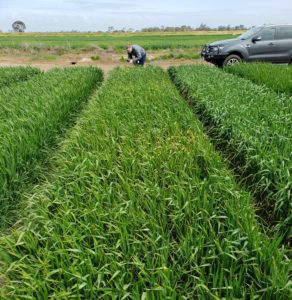
The main wheat trial saw stripe rust develop in Trojan and DS Bennett, as infection occurred before a fungicide was applied when most varieties reached GS39 or full flag emergence. This does raise the issue of how to manage variety trials – complete control of any disease and hide any weaknesses or let them suffer when a simple management tool could have reduced the problem.
Similarly the early maturity wheat trial is affected by stripe rust, with Emu Rock offering little resistance to the new strain.
Optimising Irrigated Grains
Many of the trials that make up the IAP are looking at nitrogen use efficiency in long season barley, canola and durum wheat. This includes rates as well as timing based on crop development. Dry matter cuts have been taken so as to give us a better understanding of biomass production and nitrogen management of the crops.
The faba bean trials are well into flowering, with little sign of fungal disease. Similar to the canola trials, the pre-irrigated trials are quite tall. Conversely the overhead irrigated trial has far less vegetative growth at about 56% less at early flowering. It will be interesting to see if this trial can compensate for the lower winter growth.
The overhead irrigation canola trial has also seen reduced vegetative growth when compared to the pre-irrigated flood trial. However the reduction is not quite as marked as in the fabas, with the overhead trial having 83% of the flood irrigated trial biomass at early flowering. These trials have RR and TT varieties in them, and the TT is trailing the RR biomass at 84%. Looking forward to yield predictions, yields should be quite good as we have met the 7 tonnes of biomass target at early flowering.
The chickpeas are progressing well, with little foliar disease but losing the occasional plant to root rot. One of the chickpea trials is investigating the effect of inoculation. September saw a dry matter cut at the start of flowering where no treatment (N or inoculation) has had any effect on biomass produced.
Smarter Irrigation for Profit
The 2020 SIP2 trial is looking at the effect of irrigation timing and volume on wheat yield. The demonstration is a combination of treatments using either plant growth stage or soil moisture to schedule irrigation. After the initial flood irrigation in mid-August to keep the demonstration alive, we have irrigated the ‘at booting’ treatments and a second irrigation on the plots that have scheduling based on soil moisture in September. In order to be able to have different irrigation timings without a lot of earthworks to create small bays, we have investigated the use of dripper tape laid on the surface to mimic flood irrigation. The tape, donated by Netafim, allows us to deliver 100mm of water in about 6 hours. To date the system has worked well with no issues with poor infiltration or water escaping the treatment plot.
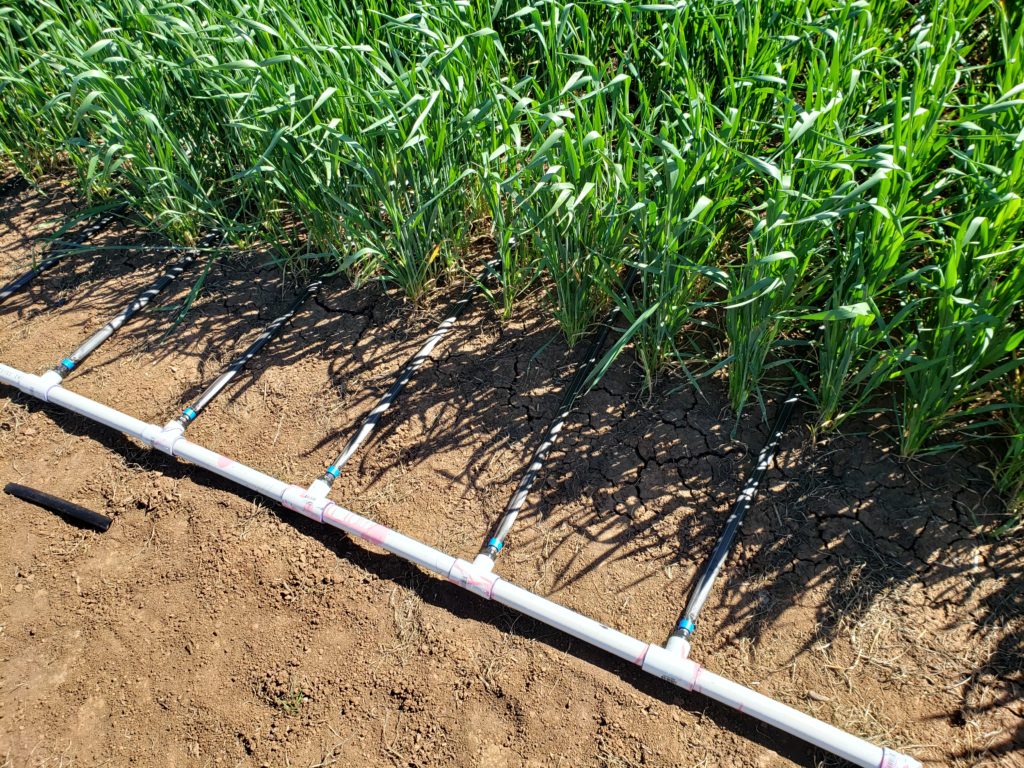
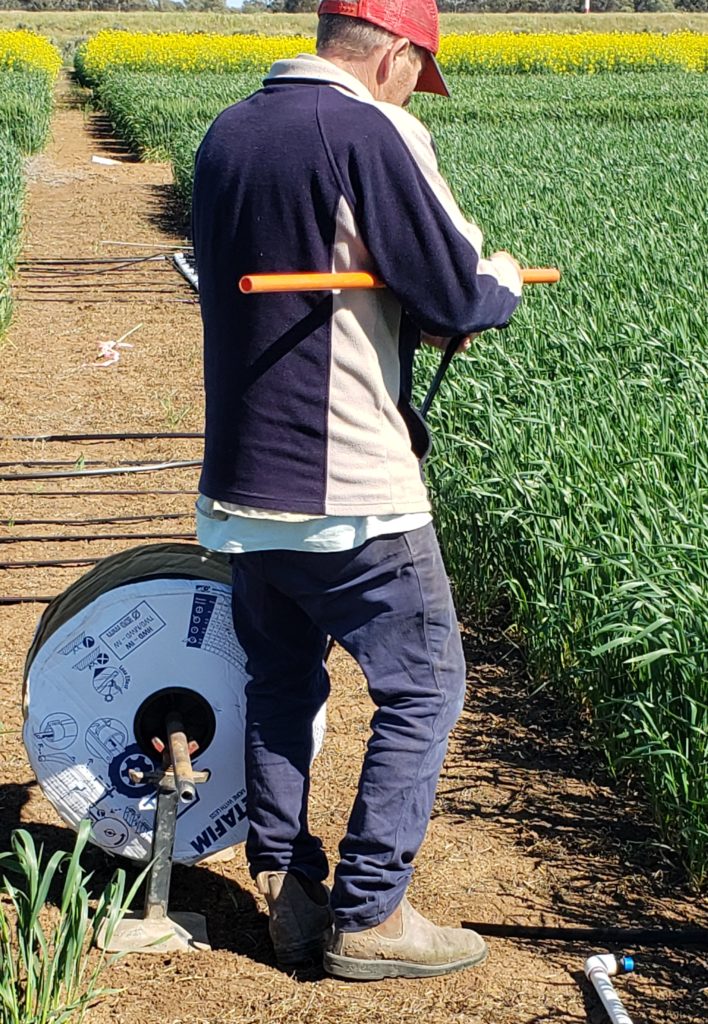
September 2020
The promised ‘wetter than average’ forecast finally came through with 48.2mm (decile 8) for August. 28 mm on the 8th broke the ‘drought’, and with follow-up rains in the middle of the month, things were quite sticky at the Trial Block. However, the soil moisture monitoring equipment installed as part of the Smarter Irrigation for Profit 2 project saw little change to the amount of soil moisture available to the crop at 30cm on our red soil that was not pre-irrigated. Therefore the trials on the red dirt were irrigated on the 17th. If you wish to see how the crop is progressing, go to the Murray Valley Soil Sensor Network website (http://murrayvalleysoilmoisture.site/) and click on the ICC – Kerang picture to see what soil moisture is available and how close we are to irrigating again.
There seems to be enough moisture on the pre-irrigated ground (the smm equipment in Bay 5 has a fault at the moment), but we are keeping an eye on soil moisture the old fashioned way with a shovel. Given the warming temperatures and lack of rainfall on the 14 day outlook, we may be irrigating relatively soon.
Last month I went through the details of making a decision on whether to irrigate, or how many times to irrigate, and a quick calculation using the ICC’s ‘Irrigate or not’ excel sheet. At the beginning August, water was at $360/Ml for Zone 7 on one of the brokers sites and wheat was sitting at about $270/t. A month later, things have changed – wheat has slipped slightly and water has come down a fair bit. The advantage of having a tool such as a spreadsheet is that you can easily change the numbers should prices fluctuate as the season progresses.
So a quick revised gross margin, assuming a 5 t/ha 1 spring irrigation strategy would require 1.4 Ml/ha and a 6.5 t/ha from a 2 spring strategy would need 2.4 Ml/ha and an extra 100 kg urea/ha.

Head to our Research and Extension Page and scroll down to resources to access the “irrigate or not” spreadsheet to run your own numbers.
Variety Trials
The ICC continues with its irrigated variety trials, thanks to the support from many of the seed companies.
The canola trial is now in full flower, with nearly all entries flowering by the middle of the month.
The long season wheat trial sown on April 17th has a few entries that may be a little too quick maturing for this sowing date. The most advanced line was at GS55 (or half the head is emerged) at the end of August and so may be at risk of frost. The two most advanced varieties are Trojan and Sherriff CL at mid-booting GS43. The longest maturity variety is Anapurna at GS32 or second node stage.
The main wheat trial has shown that stripe rust is back. Trojan is now rated as MSS and rust was detected on Trojan and another line on August 28th.
Optimising Irrigated Grains
Many of the trials are looking at nitrogen use efficiency in long season barley, canola and durum wheat. This includes rates as well as timing based on crop development. Dry matter cuts have been taken so as to give us a better understanding of how nitrogen management influences biomass production of these crops.
The faba bean trials have reached the flowering stage. The faba bean trials include disease management (using different combinations of fungicides) and plant growth regulators to potentially control excessive vegetative growth and subsequent lodging.
One of the chickpea trials is investigating the effect of inoculation. Preliminary data shows a great response to inoculation, with only few nodules on the untreated treatments. Plant growth has not been affected to date but in previous work differences in the N status of plants did not become apparent until grain fill.
The sub-soil amelioration trial combines deep ripping treatments with either organic matter or gypsum as the soil ameliorant. The organic matter used was lucerne pellets, either placed in the ripping slot or on the surface. To date, the organic ameliorant treatments are literally standing out head and shoulders over the other treatments due to the increased N added.
August 2020
July could be summed up in a word – dry. A Decile 1 10.4mm for the month has left a lot of the Trial Block in need of an irrigation. After thinking that watering up the canola was a mistake in May, it has been proven to be a good decision by July.
Recently we have installed soil moisture monitoring equipment in the Smarter Irrigation for Profit trial plots. Installed on July 9th, the sensors quickly indicated that we were close to needing an irrigation. This was in a bay that was not pre-irrigated, but did have deeper soil moisture thanks to irrigation last year. As the month progressed, the situation has only declined and we should have irrigated in the middle of the month. August 15th can’t come soon enough and we will be irrigating the ‘not pre-irrigated’ trials as soon as water is available.
Also thanks to Rubicon for installing SMM equipment in our GRDC/FAR canola trials. These trials are comparing sprinkler and flood irrigation, principally looking at the best return per megalitre, along with target populations and variety responses. To date, flood irrigation has produced about 50% more biomass than the plots that were sown on rainfall. For yield in canola, biomass is everything (to a point).
So with the SMM equipment suggesting we should be irrigating, irrigators will have to make a decision on whether it makes economic sense. To calculate returns, you need 4 key pieces of information – water price, water volume required, commodity price and estimated yield. The first three are relatively easily obtained (of course subject to market fluctuations between now and harvest or irrigation), but the estimated yields are a little more difficult and require a touch of gut feel.
To try and make some educated estimates, the ICC have been involved in a couple of projects that will give you some clues. The first was a 2019 Smarter Irrigation for Profit trial looking at a combination of pre and no pre-irrigation along with 1 or full spring irrigation strategies. These trials are written up in our 2019 Trial Results book but in a nutshell:
You had to have grown a crop worth irrigating in the first place. Irrigation didn’t create yield, biomass or tillers did.
1 spring irrigation only gave the best return per megalitre for the cereals.
Barley – 1 spring irrigation only yielded 2.75 t/ha. Pre-irrigation plus 1 spring yielded 4.0 t/ha.
Wheat – 1 spring irrigation only averaged 3.6 t/ha but was variety dependent. Pre-irrigation plus 1 spring yielded 5 t/ha.
Canola – Biomass was everything so the best return was from a fully irrigated crop. Spring irrigation alone could not restore yield.
Fabas – These could respond to irrigation but full spring irrigation was better than 1 spring.
A major difference between 2019 and 2020 is the early season rainfall – 2020 has seen moisture below 20cm and get crops off to a good start. But this growth is starting to use more water and stressing the crop.
So my guess is if you are in the situation where soil moisture is still adequate, then 1 spring irrigation could give you similar results to our 2019 ‘pre + 1 spring’ treatments.
Another project the ICC undertook on behalf of GRDC was the 2018 wheat harvest survey. A key finding was the relationship between head numbers and yield, with an average irrigated wheat crop receiving 2 spring irrigations produced 1.33 t per 100 heads/m2. So if it only got 1 spring irrigation, I would think that it would be closer to 1 t per 100 heads/m2. A well timed 2 spring irrigations might get you 1.5 t/100 heads. So if you go out and count how many tillers you have and how many spring irrigations you are thinking giving the crop, then you will be able to estimate the yield.
But a couple of points:
- All tillers present now are unlikely to produce heads. Some will die and that death rate will depend on moisture and N nutrition.
- The first spring irrigation might take more water than you think.
- So a quick gross margin figured out with the ICC’s ‘Irrigate or Not’ calculator on the bulk crop on the Trial Block suggests that a 5 t/ha target is reasonable based on tiller numbers. Assuming water is $360/Ml, applying 1.4 Ml/ha and wheat worth $270/t will return about $480/ha or $345/Ml. If you have an allocation and use the actual cost of water, then the gross margin is approximately $900/ha or $645/Ml. If we opt for the higher input crop (1 extra irrigation plus another 100kg urea/ha), then we may be looking at 6.5 t/ha and returns of $1200/ha or $500/Ml.
When it finally rains (or we irrigate), then many of our trials will get their second topdressing. As mentioned in the June update, most of our trials had good soil N levels at sowing and there has been no signs of N deficiency so far. Just keep in mind adjusting your topdressing to match target yield which may mean holding back on the N if you choose a reduced irrigation strategy.
Variety Trials
The ICC continues with its irrigated variety trials, thanks to the support from many of the seed companies. The trials have been progressing well, with pre-irrigation supplying enough moisture to keep the plants growing strongly.
It appears the frosts may have caused some leaf damage in the barley variety trial. Kerang recorded 11 mornings with a minimum temperature of less than 2 degrees during July. Banks seems to be more sensitive, with the plots easily identified by the brownish discolouration of the older leaf tips. Initially, I was thinking it was due to spot form of net blotch, but this was corrected by Steven Simpfendorfer (NSW DPI pathologist) who diagnosed it as physiological spotting and no need for a fungicide.
As per usual, Diamond won the ‘first to flower’ race in the canola variety trial. Watered up on April 24th, Diamond was in flower on July 21st. A couple of other varieties were not that far behind, but at the end of the month, most were still not flowering.
Optimising Irrigated Grains
Many of the trials that make up the IAP are looking at nitrogen use efficiency in long season barley, canola and durum wheat. This includes rates as well as timing based on crop development. The canola trials have reached the green bud stage and are now waiting for an opportunity to topdress. As discussed previously, the Trial Block has good N levels and so there is little sign of N deficiency in the trials.
A Field Walk was held on July 15th and gave a limited number of irrigators the opportunity to have a look at some of the trials and discuss the treatments and management of canola and long season barley. One of the interesting topics of the morning was canola sowing rates and the lack of visual differences between the plots despite rates varying from 20 to 80 seeds/m2 (or about 14 to 65 plants/m2 from sowing rates of approximately 0.9 to 3.8 kg/ha). Good soil moisture and N has allowed the lower sowing rates to compensate for a lack of plant numbers but preliminary data from biomass cuts have shown that the 20 seed/m2 plots have 20% less biomass than the high sowing rate plots. Another discussion centred on N management and that you can’t replace soil fertility with products out of a bag when targeting high yielding crops.
Things to consider…
Irrigation – if you haven’t starting irrigating when do you need to?
Monitoring for disease and being prepared to act if required. Even though it was dry last season, we still ended up with stripe rust in DS Bennet, Trojan and DBA Vittaroi at the site. The rust is a new race and has overcome the resistance genes in these and some other varieties. Where in the past they had some resistance, they do not now. Updated rust ratings are available from AgVic or NSW DPI. There have been twitter photos of rust already in DS Bennett.

